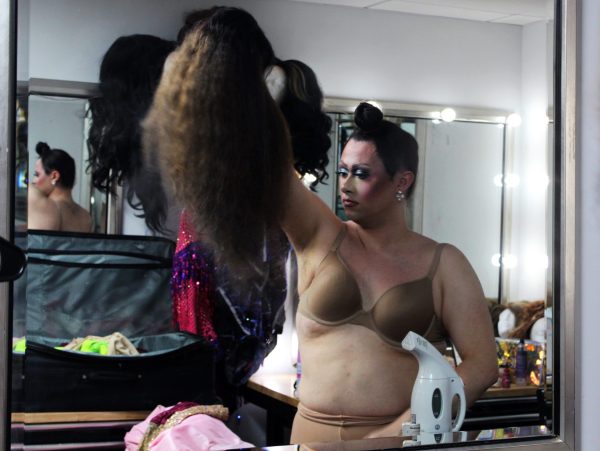End of the decade: triumphant growth in covering climate change
Jonathan Aguilar | The DePaulia
Brandon Stiffic shouts with the crowd on Friday’s Youth Climate Offensive as they march from Grant Park to the Federal Plaza demanding action from government officials to promote more environmentally conscious legislation.
Climate change is a story that is complex, multifaceted and big — perhaps the biggest issue of our time. It’s a story that doesn’t end, at least not anytime soon. Its effects surround us but are not always visible from our front porch. This is a story that affects people all over the world and spans across all journalistic beats. Yet, it is a story that has often been neglected, misrepresented and abused. But many journalists have been working over the last decade to tell the true story of climate change.
Journalists have always played an important role in shaping the way in which the public and decision makers understand and prioritize climate change. In a fast-paced world, most don’t have the time to dissect mounds of data or read through various scientific reports about the changing climate. People turn to news organizations – rightfully so – to gain a better understanding of what is going on in the world—in 900 words or less, of course.
However, the issue of climate change hasn’t been quite as seamlessly covered by media as one may expect. Over the years, journalists have had trouble reporting on the topic. Many of these difficulties often involved a lack of education on the issue, political and industry influence, a lack of prioritization of the beat in newsrooms and pressure for journalists to present both sides of the story, therefore lacking the ability to accurately represent the scientific consensus.
A 2013 study conducted by the Project for Improved Environmental Communication (PIEC) found that environmental stories only made up one percent of headlines within the United States.
The inconsistency of this specialized reporting largely had to do with the event-driven characteristics of most mainstream news. Climate change, especially at the start of the decade, did not always play into this event-driven coverage that journalists are urged to chase after.
Historically, and even today, event-driven coverage is the essence of most news organizations, which can play into determining what issues receive in-depth coverage and what issues do not. The problem lies in the fact that environmental issues often don’t happen quickly or as dramatically as some mainstream coverage would like us to think.
When climate was covered, it was often approached as an issue still up for debate, sparking uncertainty amongst the public and giving validity to politicians who cast doubt on the legitimacy of climate change, oftentimes in the interest of the fossil fuel industry and other financial stakeholders.
However, the science has been quite conclusive for years. A survey of 928 scientific journal articles published between 1993 and 2003 all concluded that human activities are causing climate change. As of 2013, 97 percent of scientists agreed that climate change is occurring and that it is perpetuated by human activity.
Despite this scientific consensus, many journalists continued to give climate skeptics and deniers a platform, hoping to tell both sides of a one-sided story. Many scholars suggest that this created a false sense of balance within the media and led to a misinformed public. While journalists are generally trained to produce a balanced story and remain unbiased in their reporting, giving airtime to climate skeptics creates a sense of uncertainty about the science. This type of climate coverage did not accurately represent the scientific consensus among climate scientists, and perpetuated a confused public that did not clearly understand the urgency of the issue.
“By presenting two people who are in opposition on the issue, it can make it appear as if there is a split view 50-50, across the U.S. or in the scientific community, on whether climate change exists or if it is caused by human activity,” said Barbara Willard, a scholar and professor of environmental communication at DePaul. “This is just simply not the case. The science has been direct for years.”
Part of this issue lies in the lack of training journalists receive in understanding and communicating science. In 2015, the Knight Center for Environmental Journalism reported that only 12 percent of environmental journalists have degrees in scientific or environmental fields.
In 2008, the Columbia Journalism Review said “‘the era of “equal time’” for skeptics who argue that global warming is just a result of natural variation and not human intervention seems to be largely over.” However, they reported that this was not true for talk radio, cable and local television, which all tended to still frame climate change as an issue up for debate among scientists. The esteemed publication went on to deem this failure to accurately cover climate change as “poor reporting.”
During this time, the UN Intergovernmental Panel on Climate Change (IPCC) released a comprehensive report that provided the most complete scientific agreement to date, which highlighted the human impact on climate change and warned of devastating effects if action was not taken.
This had many environmental journalists, such as Andrew Revkin and Bill McKibben, as well as some organizations such as the Columbia Journalism Review, calling for better, more comprehensive climate coverage.
Online journalism sites started to form, such as the well-respected site, the Yale Forum on Climate Change & The Media. This journalism site aimed to increase and improve coverage on climate change, as well as show reporters how climate change would influence and affect a diverse set of beats through online articles and even workshops for top reporters and editors.
Still, many journalists feared the depressing nature of the subject, concerned that audiences would tune out or lack interest in the subject. However, this was not the case. Over the decade, news organizations that have made an effort to cover climate found that their viewers, listeners and readers were quite engaged in the conversation, especially younger audiences.
Navigating the role between straightforward reporter and new-aged activist is another issue journalists struggled with when it came to covering climate. It is an issue that many journalists still face today.
This fear among the journalism community can largely be attributed to the nature of climate change being an often politically polarizing issue throughout the years, especially in the United States. In order to mitigate climate change, scientists argue that there needs to be a reduction in man-made greenhouse gas emissions, which would require government regulation and pose financial threats to the fossil fuel industry and free-market capitalism.
As a result, those who tend to favor industry regulation and green initiatives have been mainly associated with the Democratic party, and those who have been the most resistant to change are conservatives in the Republican party, turning an environmental issue into a political brawl.
Journalists have often felt the need to give climate skeptics a voice in an effort to not appear to align with any one political party.
“Journalism has always been about righting wrongs, holding the powerful to account, calling out lies,” The Nation suggests. “It is in our best traditions to shine a light on our most vexing problems, in order to help fix them.”
Understanding the broader consensus amongst the scientific community, and reflecting that consensus through reporting is no longer considered partisan, it is considered communicating factual evidence to the public. As we approach the end of the decade, news organizations have become more outspoken on the issue.
A decade of change
A decade of growth has perspired when it comes to reporting on climate. The effects of climate change have become worse over the last 10 years, and the reporting has become more urgent and prioritized by newsrooms across the board.
The demand for more and better climate-related coverage is increasing. According to a recent poll by the PIEC, 79 percent of Americans report that they want better environmental news coverage.
In September, the Columbia Journalism Review and The Nation organized “Covering Climate Now,” a commitment by 323 news outlets from 47 countries to provide sustained climate change coverage for a full week. This initiative also encouraged news organizations to continue on after that week to make climate change coverage a central part of their newsroom.
“Coverage has increased over the last decade tremendously, especially more recently as the signs of climate change have become more severe,” Willard said. “I believe it has increased awareness across the world. This, along with the notability of [youth activist] Greta Thunberg and the many that follow her, is an exciting advancement in climate coverage.”
Increasingly, news organizations have been working to reorganize and rebuild their environment sections due to a high demand for better climate coverage, with organizations like The New York Times, The Guardian and The Washington Post hiring more reporters to solely focus on climate and environmental beats.
The way in which journalists are approaching the multifaceted issue is ever-changing and highlights the way in which climate change stretches across multiple beats.
“One interesting shift that I have seen in the media is the shift from a biocentric perspective to an anthropocentric [human-focused] point-of-view,” said Nicole Granados, founder of the Climate Reality Project at DePaul. “We have shifted from covering the impact that climate change has on the coral reef or the amazon rainforest to how people will be impacted by such drastic changes, and I think that is an effective strategy.”
There has also been an increase in coverage communicating the links between extreme weather events such as wildfires, flooding and hurricanes to climate change. Even major investment banks have taken initiatives to evaluate the economic impact of climate change, giving journalists more opportunity to cover the financial story behind the problem and how a lack of action will result in costly consequences.
An important shift has also occurred in the way in which the public understands and perceives climate change. Over 70 percent of Americans acknowledge that climate change is happening and that it is perpetuated by human activity, according to the Yale Program on Climate Change Communication.
“The tone surrounding the climate change conversation has completely shifted,” said Alliyah Martinez, an environmental studies student at DePaul. “In the past, climate change was situated on the periphery of sociopolitical issues. With greater awareness has come a larger demand for accountability and a plan that will [strive] to rectify the damage that has been done.”
There is also an increasing support system for journalists working on an environmental discipline. The Society of Environmental Journalists (SEJ) exists to “strengthen the quality, reach and viability of journalism across all media to advance public understanding of environmental issues.”
As of 2018, SEJ reports that more than 1,400 journalists are part of this network working to tell a more accurate and relevant story of climate change.











